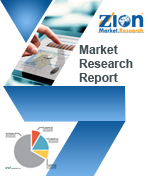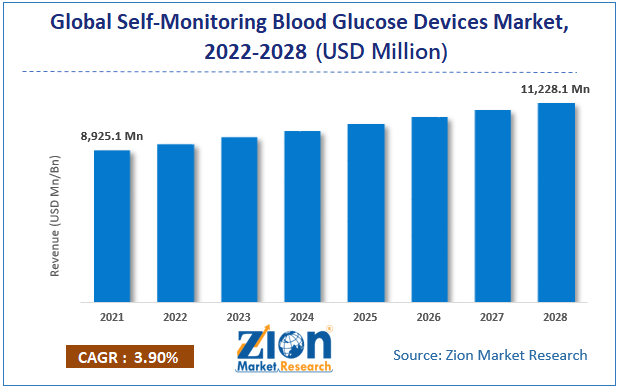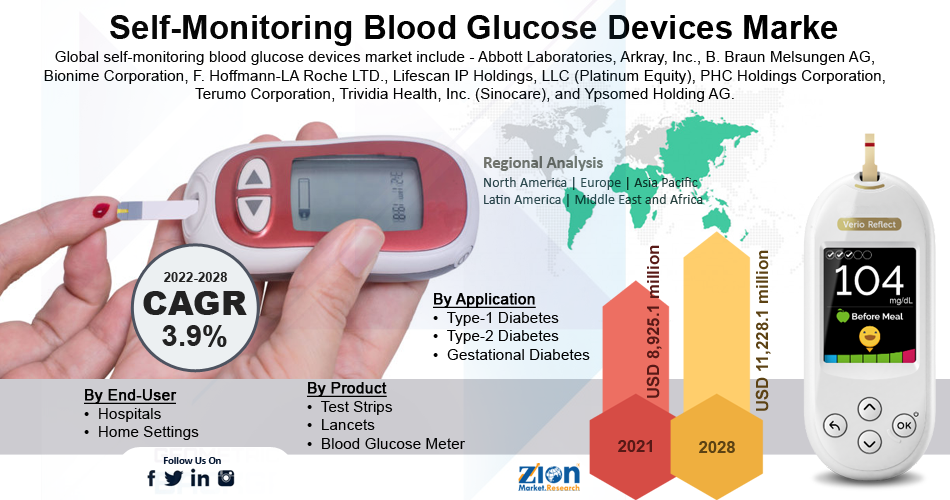Global Self-Monitoring Blood Glucose Devices Market Size, Share, Growth Analysis Report - Forecast 2034

Self-Monitoring Blood Glucose Devices Market By Product (Blood Glucose Meters, Test Strips, Lancets), By Application (Type 1 Diabetes, Type 2 Diabetes, Gestational Diabetes), End User (Hospitals, Home Settings, Diagnostic Centers), Distribution Channel (Retail Pharmacies, Online Pharmacies, Others), and By Region: Global and Regional Industry Overview, Market Intelligence, Comprehensive Analysis, Historical Data, and Forecasts 2025 - 2034
| Market Size in 2024 | Market Forecast in 2034 | CAGR (in %) | Base Year |
|---|---|---|---|
| USD 19.76 Billion | USD 59.53 Billion | 11.66% | 2024 |
Self-Monitoring Blood Glucose Devices Market: Industry Perspective
The global self-monitoring blood glucose devices market size was worth around USD 19.76 Billion in 2024 and is predicted to grow to around USD 59.53 Billion by 2034 with a compound annual growth rate (CAGR) of roughly 11.66% between 2025 and 2034.
The report analyzes the global self-monitoring blood glucose devices market's drivers, restraints/challenges, and the effect they have on the demands during the projection period. In addition, the report explores emerging opportunities in the self-monitoring blood glucose devices industry.
Self-Monitoring Blood Glucose Devices Market: Overview
Blood glucose monitoring helps patients with diabetes make daily management decisions such as insulin dose, food intake, and physical exercise. Self-monitoring blood glucose (SMBG) is an advanced diabetes management procedure. It includes using blood glucose metrics by patients to check their respective glucose levels and provide an appropriate measure of capillary glucose concentration.Self-monitoring blood glucose technology uses lancets, test strips, and blood glucose meters to achieve long-term glycemic control. The growth of self-monitoring blood glucose devices can be attributed to factors such as an increase in risk factors that lead to diabetes and a rise in the incidence rate of diabetes. However, blood glucose monitoring devices have some shortcomings. They do not measure the exact glucose level in the blood and can give inaccurate results, thereby hampering the market growth.
Key Insights
- As per the analysis shared by our research analyst, the global self-monitoring blood glucose devices market is estimated to grow annually at a CAGR of around 11.66% over the forecast period (2025-2034).
- Regarding revenue, the global self-monitoring blood glucose devices market size was valued at around USD 19.76 Billion in 2024 and is projected to reach USD 59.53 Billion by 2034.
- The self-monitoring blood glucose devices market is projected to grow at a significant rate due to rising diabetes prevalence, increasing health awareness, demand for at-home monitoring solutions, and technological advancements in glucose sensing.
- Based on Product, the Blood Glucose Meters segment is expected to lead the global market.
- On the basis of Application, the Type 1 Diabetes segment is growing at a high rate and will continue to dominate the global market.
- Based on the End User, the Hospitals segment is projected to swipe the largest market share.
- By Distribution Channel, the Retail Pharmacies segment is expected to dominate the global market.
- Based on region, North America is predicted to dominate the global market during the forecast period.
Self-Monitoring Blood Glucose Devices Market: Growth Drivers
Increasing awareness regarding the use of self-monitoring blood glucose devices to drive the market growth
Self-monitoring blood glucose devices are predicted to showcase a high growth rate. Self-monitoring blood glucose devices are witnessing robust advances along with several launches by major players. Moreover, demand for self-monitoring blood glucose devices increased due to a rise in awareness regarding the usage of self-monitoring blood glucose devices and their benefits. Additionally, the rise in the geriatric population and technological advancements in blood glucose monitoring devices will boost the growth of the global self-monitoring blood glucose devices market.
Self-Monitoring Blood Glucose Devices Market: Restraints
Shortcomings of self-monitoring blood glucose devices hinder the market growth
Self-monitoring blood glucose devices have shortcomings, such as not measuring the exact blood glucose level and can give inaccurate results, which hampers the market growth.
Self-Monitoring Blood Glucose Devices Market: Opportunities
Technological advancements to present market opportunities
Technological advancements in the self-monitoring blood glucose devices owing to an increase in the adoption of these technologies to manage diabetes will provide opportunities for key players in the global self-monitoring blood glucose devices market. At the same time, increasing awareness of diabetes monitoring devices is expected to promote the market's growth.
Self-Monitoring Blood Glucose Devices Market: Challenges
High cost of self-monitoring blood glucose devices
The cost of self-monitoring blood glucose devices is high, and it is still difficult for many target customers to afford them. Hence, the self-monitoring blood glucose devices market is stagnant in countries with lower disposable income and low purchasing power.
Recent Developments
- February 2020: Abbott partnered with Insulet to integrate its Continuous Glucose Monitor technology with Insulet’s automated insulin delivery system.
- January 2020: Tandem Diabetes Care, Inc., an insulin delivery and diabetes technology company, announced the launch of the t:slim X2™ insulin pump with Control-IQ™ technology.
Self-Monitoring Blood Glucose Devices Market: Segmentation
The global self-monitoring blood glucose devices market is segregated based on product, application, and end-user.
Based on product, the market is divided into test strips, lancets, and blood glucose meters. Among these, the test strip segment dominates the market, accounting for a major share of global sales in 2021 due to greater knowledge of self-testing, which enables diabetic patients to frequently track their blood glucose levels without having to visit a clinic or diagnostic laboratory. Furthermore, the global market for self-monitoring blood glucose devices is growing due to the rising prevalence of diabetes and the increased demand for improved screening & monitoring techniques.
Based on application, the market is classified into type-1 diabetes, type-2 diabetes, and gestational diabetes. In 2021, the type-2 diabetes segment developed at fastest rate. An increase in the number of patients with type-2 diabetes is driving the segment's growth. Furthermore, due to a growth in the number of older adults, an increase in the prevalence of obesity, and a sedentary lifestyle, the type 2 diabetes sector is anticipated to develop at the quickest rate during the projection period.
Based on end-user, the market is classified into hospitals and home settings. The hospital's segment dominated the market in 2021, accounting for a major share of global revenue due to the expansion of healthcare infrastructure throughout emerging nations and an overall rise in hospitalizations. However, due to the increased adoption of blood glucose self-monitoring devices and the rise in consumer desire for portable & high-end technological products, the home settings category is anticipated to grow at the quickest rate during the projected period.
Self-Monitoring Blood Glucose Devices Market: Report Scope
| Report Attributes | Report Details |
|---|---|
| Report Name | Self-Monitoring Blood Glucose Devices Market |
| Market Size in 2024 | USD 19.76 Billion |
| Market Forecast in 2034 | USD 59.53 Billion |
| Growth Rate | CAGR of 11.66% |
| Number of Pages | 254 |
| Key Companies Covered | Abbott Laboratories, Dexcom, Medtronic, Roche, Ascensia Diabetes Care, Senseonics, Nemaura Medical, Know Labs, BioXensor, DiaMonTech, and others. |
| Segments Covered | By Product, By Application, By End User, By Distribution Channel, and By Region |
| Regions Covered | North America, Europe, Asia Pacific (APAC), Latin America, The Middle East and Africa (MEA) |
| Base Year | 2024 |
| Historical Year | 2020 to 2023 |
| Forecast Year | 2025 - 2034 |
| Customization Scope | Avail customized purchase options to meet your exact research needs. Request For Customization |
Self-Monitoring Blood Glucose Devices Market: Regional Analysis
North America dominated the self-monitoring blood glucose devices market in 2034
North America acquired a major share of the global self-monitoring blood glucose devices market in 2021 due to the region's high incidence rate of diabetes. Moreover, the presence of key players in North America promotes the market's growth. Further, the constantly evolving healthcare industry drives the market growth in this region.
The CDC estimates that 34.2 million Americans will have diabetes in 2020, and one in three people in the country have prediabetes. The patient base is further augmented by obesity, unhealthful eating patterns, and other environmental variables. The industry's expansion will also be fueled by several initiatives launched by national and international organizations to lower the disease burden.
Self-Monitoring Blood Glucose Devices Market: Competitive Analysis
The report provides a company market share analysis to give a broader overview of the key market players. In addition, the report also covers key strategic developments of the market, including acquisitions & mergers, new product launches, agreements, partnerships, collaborations & joint ventures, research & development, and regional expansion of major participants involved in the self-monitoring blood glucose devices market on a global and regional basis.
The global self-monitoring blood glucose devices market is dominated by players like:
- Abbott Laboratories
- Dexcom
- Medtronic
- Roche
- Ascensia Diabetes Care
- Senseonics
- Nemaura Medical
- Know Labs
- BioXensor
- DiaMonTech
The global self-monitoring blood glucose devices market is segmented as follows;
By Product
- Blood Glucose Meters
- Test Strips
- Lancets
By Application
- Type 1 Diabetes
- Type 2 Diabetes
- Gestational Diabetes
By End User
- Hospitals
- Home Settings
- Diagnostic Centers
By Distribution Channel
- Retail Pharmacies
- Online Pharmacies
- Others
By Region
- North America
- The U.S.
- Canada
- Mexico
- Europe
- France
- The UK
- Spain
- Germany
- Italy
- Rest of Europe
- Asia Pacific
- China
- Japan
- India
- Australia
- South Korea
- Rest of Asia Pacific
- The Middle East & Africa
- Saudi Arabia
- UAE
- Egypt
- Kuwait
- South Africa
- Rest of the Middle East & Africa
- Latin America
- Brazil
- Argentina
- Rest of Latin America
Table Of Content
Methodology
FrequentlyAsked Questions
Which key factors will influence self-monitoring blood glucose devices market growth over 2025-2034?
The global self-monitoring blood glucose devices market is expected to grow due to rising prevalence of diabetes, increasing health awareness, and demand for portable, real-time glucose monitoring solutions.
According to a study, the global self-monitoring blood glucose devices market size was worth around USD 19.76 Billion in 2024 and is expected to reach USD 59.53 Billion by 2034.
The global self-monitoring blood glucose devices market is expected to grow at a CAGR of 11.66% during the forecast period.
Which region will contribute notably towards the self-monitoring blood glucose devices market value?
North America is expected to dominate the self-monitoring blood glucose devices market over the forecast period.
Leading players in the global self-monitoring blood glucose devices market include Abbott Laboratories, Dexcom, Medtronic, Roche, Ascensia Diabetes Care, Senseonics, Nemaura Medical, Know Labs, BioXensor, DiaMonTech, among others.
The report explores crucial aspects of the self-monitoring blood glucose devices market, including a detailed discussion of existing growth factors and restraints, while also examining future growth opportunities and challenges that impact the market.
RelatedNews
HappyClients
Zion Market Research
Tel: +1 (302) 444-0166
USA/Canada Toll Free No.+1 (855) 465-4651
3rd Floor,
Mrunal Paradise, Opp Maharaja Hotel,
Pimple Gurav, Pune 411061,
Maharashtra, India
Phone No +91 7768 006 007, +91 7768 006 008
US OFFICE NO +1 (302) 444-0166
US/CAN TOLL FREE +1 (855) 465-4651
Email: sales@zionmarketresearch.com
We have secured system to process your transaction.
Our support available to help you 24 hours a day, five days a week.
Monday - Friday: 9AM - 6PM
Saturday - Sunday: Closed






